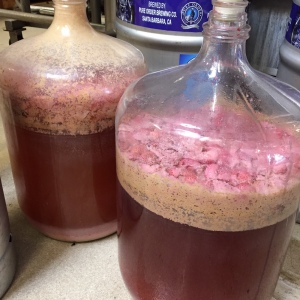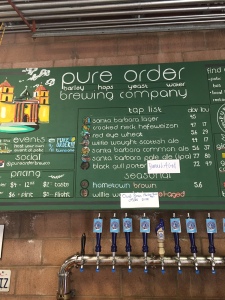Recently, I had the opportunity to give a short speech at Blue Box 2015 — a conference hosted by First Beverage Group in Boulder, Colorado. It was a great opportunity to mingle with some movers and shakers in the beverage world, but I took it as a chance to talk about what it means to be part of a brewing community, and a collaborator within that community.
I believe video from that conference will be up soon, and I’ll post a link when that happens. But rather than laboring through a video of me nervously addressing strangers, you need look no further than one of our own local breweries to see what it means to be part of a brewing community.
Pure Order Brewing Company on 410 Quarantina Street is the epitome of the neighborhood brewery. They, along with Telegraph Brewing on Salsipuedes Street, are where the locals go for a drink when the crowds of visitors in the Funk Zone get a bit outside of comfort range. And for good reason — both breweries are making incredible beer.
Pure Order was recently among the winners at the Casa Pacifica in Ventura along with Institution Ales from Camarillo and The LAB in Agoura. While those other two are both great breweries, Pure Order was the only one in the winner list with a beer off its standard and regular production line — the Santa Barbara Pale. That beer will also be part of the upcoming Cost Plus World Market Summer Seasonal Variety Pack, which will be available nationwide. That’s a pretty big deal.
And yet, it’s Pure Order’s ability to keep things small and local that sets them apart. Recently, they’ve been helping me out by loaning their time, space and some equipment to help me brew 60 gallons of beer for a friend’s upcoming June wedding (and yes, full disclosure, this help is greatly appreciated and I’m sure impacts my favorable bias toward them. They also carry my book, We Make Beer, so I’m sure that doesn’t hurt either. I’m only human, but I like to believe that my opinions can remain relatively objective). This isn’t just because I write a beer column in the local newspaper or because I run this blog. James Burge and Pure Order are willing to help me out because I’m part of the local brewing community — the same way I’ve seen them help out home brewers who come in looking for advice and perhaps experience.

10 gallons of Strawberry Solstice, a collaboration beer I’ve brewed with Pure Order Brewing Company for an upcoming wedding.
More and more often I hear locals tell me that Pure Order is their favorite brewery in town. I don’t think that’s a knock on any of the other breweries, as just about every brewery from Buellton to Carpinteria is producing high-quality beer right now (and one need look no further than the recent Dia de Los Obscuras to see how the beer community has embraced Telegraph). I think what that represents is how Pure Order has managed to capture Santa Barbara’s essence. Not just in the beer, but in the entire atmosphere provided at the brewery and its beer garden.
Beer isn’t just a business, at least it shouldn’t be. The best breweries aren’t just the ones pumping out the best liquid, they’re also the ones that represent and collaborate within the community (along those lines — there was a recent Instagram post from Kevin Ashford from Fig Mountain’s SB brewery showing a collaboration effort with Island Brewing’s Ryan Morrill, as well as both breweries’ brewing teams). Pure Order, certainly isn’t the only local brewery to embrace the community, but it’s embraced me, and I’m grateful.
edit: a previous version of this post misidentified Ryan Morrill as a brewer for Telegraph — he is the head brewer for Island Brewing in Carpinteria.





